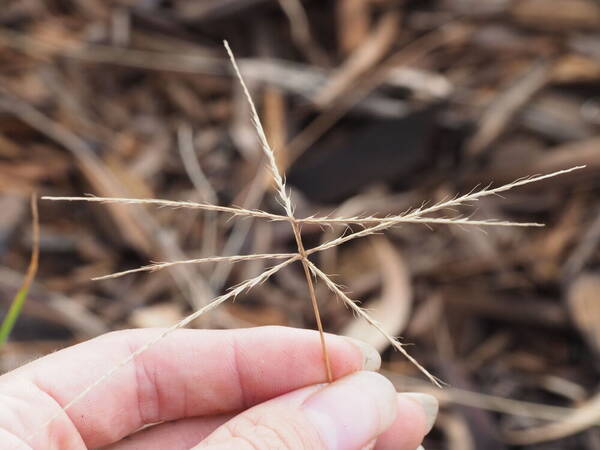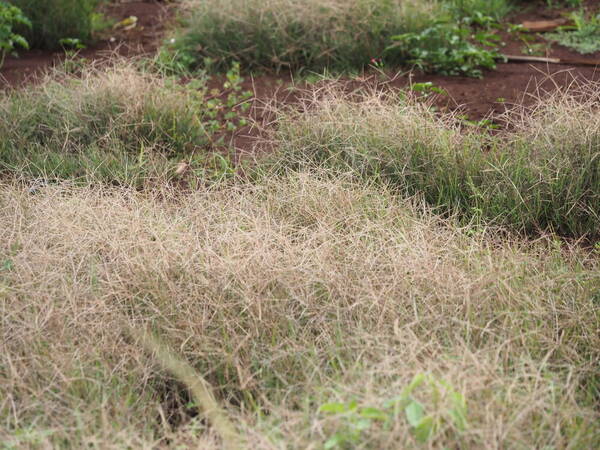Info
Subfamily: Chloridoideae
Genus etymology: Chloris = Goddess of vegetation [Greek], generally used to refer to a pale green color
Species etymology: divaricata = "widely spread" [Latin] refering to the inflorescence branches
Photosynthetic type: C4 (warm season)
Nativity: naturalized - accidental
First recorded in Hawaiʻi: 1924
Map


Inflorescence







Plant




Habit



Spikelets




Collar

Description
Plants perennial; cespitose to shortly stoloniferous. Culms 20-50 cm. Sheaths glabrous; ligules membranous, ciliolate; blades to 15 cm long, 1-1.5 mm wide, glabrous or scabrous. Panicles digitate, with 3-9 branches; branches 4-17 cm, evidently distinct, becoming horizontal, spikelet-bearing to the base or within 0.5 cm of the base, distal portion with 3-7 spikelets per cm. Spikelets appressed, with 1 bisexual and 1 sterile floret. Lower glumes 0.9-1.8 mm; upper glumes 2-2.9 mm; lowest lemmas 2.9-4 mm, linear to narrowly lanceolate, mostly glabrous or scabrous, margins glabrous or with a few short, appressed hairs near the apices, 1-3-awned, central awns 7.5-17 mm, lateral lobes unawned or with awns less than 0.4 mm; second florets 1.2-1.9 mm, narrowly elliptic, bilobed for 1/3–1/2 of their length, apices acute, awned from between the lobes, awns 4.5-9.5 mm. Caryopses about 2.2 mm long, about 0.4 mm wide, narrowly ellipsoid. 2n = unknown.
(Description source: Barkworth, M.E., Capels, K.M., Long, S. & Piep, M.B. (eds.) 2003. Flora of North America, north of Mexico. Volume 25. Magnoliophyta: Commelinidae (in part): Poaceae, Part 2. Oxford University Press, New York. 783 pp. http://floranorthamerica.org/Chloris_divaricata )
Branched perennials with slender, creeping stolons; culms erect or sometimes prostrate, 20-40 cm tall, glabrous. Sheaths shorter than the internodes, usually somewhat keeled, often slightly inflated, glabrous, margins sometimes scarious; ligule a row of hairs ca. 0.5 mm long; blades flat or involute, 4-20 cm long, 1-2 mm wide, upper surface scabrous. Inflorescences consisting of 4-7 spikes, each one 4-20 cm long, digitately arranged at apex of rachis, spreading, slender; spikelets 2-flowered, 3- 4 mm long (excluding awns), closely appressed to rachis; glumes narrow, with 1 scabrous nerve, acuminate, first glume 1.5- 2 mm long, second glume ca. 3 mm long; first lemma subcoriaceous, 3-3.5 mm long, narrow, scaberulous and ciliate in upper part, attenuate, awn 5-6 mm long; first palea ca. 2 mm long, narrow, scabrous on keels; rudimentary lemma narrow, ca. 1.5 mm long, acute, bifid, awn 1.5-2 mm long. Caryopsis golden brown, ca. 2 mm long, narrow, triangular, attenuate at both ends.
(Description source: O’Connor, P.J. 1990. Poaceae, pp. 1481–1604. In: Wagner W.L., Herbst D.R. & Sohmer S.H. (eds.)., Manual of the flowering plant of Hawaiʻi. Vol. 2. University of Hawaii Press & Bishop Museum Press, Honolulu )